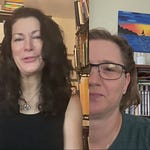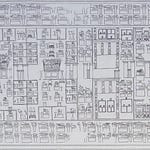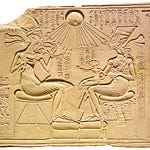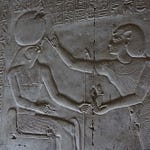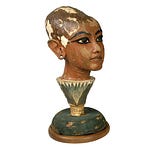Anya and I had so much fun in our recent Substack Live with
. Anya was in Greece, I in California, and the topic was ancient Egypt. One of our main points of discussion was the newly conserved hypostyle hall at Karnak, which Anya had just seen in person. Enthusiastic as I am about this extraordinary space, I expressed a teeny tiny bit of concern about fresh paint colors being newly revealed. Don’t get me wrong: the newly conserved hypostyle hall looks bright and fresh, but we must remember that these colors are now exposed to air and light, and that means degradation. I have to assume the columns have been convered in some modern material to avoid decay, but one worries nonetheless. I am very much torn about all this conservation, and a large part of me is happy to have them more safely preserved under layers of soot and dirt. But that’s problematic protectionism, perhaps. In addition, I mentioned to Anya how the cracks between the column drums are now covered with modern conservation materials—which indeed better reconstructs how they would have looked in the Ramesside period. But, it limits our study: the joins between column drums are now invisible, and given many of them were put back in the wrong places after collapse, there is no way to further study the individual parts and construction methods of the hypostyle hall. We must be very grateful to Peter Brandt for his team’s published documentation of the hypostyle hall before this extensive conservation. Indeed, in my own work with coffin reuse I find myself apoplectic when a coffin has been so conserved that I cannot see where painted plaster has fallen away from the wood. Making the object perfectly beautiful almost always destroys further research possibilities; indeed, it also makes the object more modern than it is ancient…but this is a topic all on its own, and I’ll leave it there!Anya and I also discussed the extraordinary geology underneath the Giza Plateau—because that is what was recently discovered with ground penetrating radar: rock formations. It is our own human minds that are making this geology into human / alien constructions. The Giza pyramids were built on this plateau for a reason; this is and was a dynamic and awe-inspiring place. There was a rock formation on this plateau in the shape of a crouching lion! Because that leonine outcropping was shaped into a human headed Sphinx with nemes headdress and beard by the ancient Egyptians, we humans have cognitively transformed this entire space into a humanly constructed one. I would urge caution: this is an earthly plain perceived as magical and empowered, thus chosen by 4th Dynasty kings for their mountains of stone. If we put this into a Chicken and Egg dynamic, the plateau came first; it is the Egg. But the Chickens—those three pyramids— are so overwhelming to our senses that they have somehow transformed our view of the Egg. To really understand the power of this space, and these recent discoveries, I urge us all to imagine a Giza Plateau in the millennia before human claims and transformations.
And then Anya’s internet connection died (!), at which point I strangely and abruptly ended the live feed! Ah well, but we at have learned a few things about live Substacks and will attempt a few of our own. So be on the lookout.
Thank you
, , , , , and many others for tuning into my live video with ! Join me for my next live video in the app. :)







